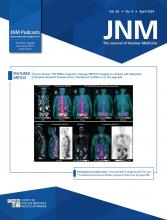Abstract
Under Medicare’s Coverage with Evidence Development policy, PET using 18F-sodium fluoride (NaF PET) to identify osseous metastasis became a covered service if prospective registry data were collected. The National Oncologic PET Registry (NOPR) developed a NaF PET registry built on the foundation of its prior registry for PET with 18F-FDG. Men with prostate cancer represented 72% of the cases. Methods: Prospective data before and after NaF PET were collected from referring and interpreting physicians. The analysis set consisted of consenting men age 65 y or older with prostate cancer undergoing NaF PET for initial staging (IS, n = 1,024), suspected first osseous metastasis (FOM, n = 1,997), or suspected progression of osseous metastasis (POM, n = 510). Results: Referring physicians indicated that if NaF PET were not available, other advanced imaging (body CT, MR imaging, or 18F-FDG PET) would be their plan in about half of the cases. After NaF PET, the postimaging plan was revised to treatment in 77%, 52%, and 71% for IS, FOM, and POM, respectively. When intended management was classified as either treatment or nontreatment, the overall change in intended management ranged from 44% to 52% and from 12% to 16% if no effect was assumed for those cases with pre-PET plans for other imaging (imaging-adjusted impact). Interpreting physicians recorded definite findings of bone metastasis in 14%, 29%, and 76% for IS, FOM, and POM, respectively. The intended care patterns varied widely across indication and scan abnormality category combinations. Conclusion: NaF PET has high overall impact, principally related to its effect on replacing intended use of other advanced imaging. Its imaging-adjusted impact was similar to that observed with 18F-FDG PET for restaging or suspected recurrence in other cancer types.
Footnotes
↵† Deceased.
Published online ▪▪▪▪▪▪▪▪▪▪▪▪.
- © 2014 by the Society of Nuclear Medicine and Molecular Imaging, Inc.







